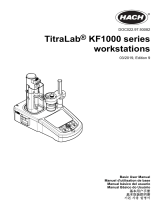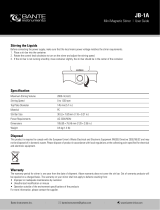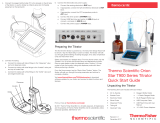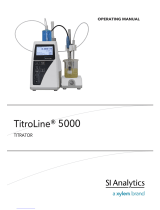Page is loading ...

1
QUICK START GUIDE
HI 904
KARL FISCHER
COULOMETRIC TITRATOR
Revision 1.0
www.hannainst.com

2
QUICK START GUIDE
Dear customer,
Congratulations on choosing a Hanna Instruments Product.
This guide has been written for the HI 904 Karl Fischer Coulometric Titrator.
Please read this Quick Start Guide carefully before using the instrument. This guide will
provide you with the necessary information for the correct use of the instrument.
The purpose of this guide is to present a quick overview of setting up and using the
instrument.
For detailed information illustrating the extensive capabilities of your titrator, please refer to
the Instruction Manual.
Hanna Instruments
All rights are reserved. Reproduction in whole or in part is prohibited without the written consent of the copyright
owner, Hanna Instruments Inc., 584 Park East Drive, Woonsocket, Rhode Island, 02895, USA.

3
QUICK START GUIDE
Contents
INTRODUCTION ..........................................................................................................5
SAFETY MEASURES.....................................................................................................6
TITRATOR CONNECTIONS .........................................................................................7
USER INTERFACE .........................................................................................................8
HOW TO SELECT YOUR LANGUAGE ............................................................................9
HOW TO USE THE CONTEXTUAL HELP .......................................................................9
METHODS ....................................................................................................................9
BEFORE PERFORMING THE FIRST TITRATION........................................................10
HOW TO PERFORM THE FIRST TITRATION ..............................................................10

4
QUICK START GUIDE

5
QUICK START GUIDE
INTRODUCTION
The HI 904 Karl Fischer Coulometric titrator is extremely flexible, capable of performing a
wide variety of highly accurate and precise water content titration methods.
The HI 904 finds a titration endpoint using a polarized electrode and an advanced detection
algorithm. A constant flow of current is maintained between the two platinum pins of the
titrator’s electrode. When the solution in the titration vessel contains water, a relatively
large voltage is required to maintain the flow of current between the pins. As the titration
proceeds, the water in the sample is consumed by the iodine that is generated electrolytically
within the vessel. At the end point, all of the water has been reacted and the cell contains
excess iodine. The presence of excess iodine within the titration cell results in a reduction
in the amount of voltage required to maintain the constant current between the pins of the
electrode. The endpoint detection algorithm incorporated in the HI 904 analyzes both the
electrode response to individual additions of iodine and the shape of the entire titration
curve in order to determine the endpoint of the titration.
Titration reports and methods can be transferred to a PC via a USB interface, saved to a USB
flash drive or printed directly from the titrator. An external monitor and keyboard can be
attached for added convenience.
How can I find certain information?
1. This Quick Start Guide will help the user learn how to operate the titrator within
a short period of time. The first analysis will be performed with the aid of the
factory stored methods.
2. The Instruction Manual provides a complete description of the operating principles
(user interface, general options, methods, titration mode, maintenance, etc.).
3. The contextual Help screens contain detailed explanations about what kind of data
can be set or viewed in every displayed screen.
4. The Titration Theory booklet outlines the basic concepts of titration.

6
QUICK START GUIDE
SAFETY MEASURES
The following safety measures must be followed:
1. Never connect or disconnect the pump assemblies with the titrator turned on.
2. Always check that the reagent and waste bottles, as well as the titration vessel are properly
assembled.
3. Always wipe up spills and splashes immediately.
4. Avoid the following environmental working conditions:
• Severe vibrations
• Direct sunlight
• Atmospheric relative humidity above 80% non-condensing
• Environment temperatures below 10°C and above 40°C.
• Near heating or cooling sources
• Explosion hazards
5. Have the titrator serviced by qualified service personnel only.
6. Avoid inhalation of reagent vapors. Avoid contact with chemicals.

7
QUICK START GUIDE
TITRATOR CONNECTIONS
Front View
Rear View

8
QUICK START GUIDE
USER INTERFACE
Keypad
The titrators have their own keypad with 29 keys grouped in four categories, as follows:
Display
The titrators have a 5.7” graphical backlit color display. The
Standby Mode
screen
is shown
below
with short explanations.
The user interface contains several screens. In each screen, many information fields are
present at the same time. The information is displayed in an easy-to-read manner, using
different size fonts.
Virtual option keys describe the function performed when the corresponding soft key is pressed.

9
QUICK START GUIDE
HOW TO SELECT YOUR LANGUAGE
To change the language, press from the main
screen. Highlight the
Language
option and then
press . Using the and keys select the
language from the options listed in the
Set Language
screen and press .
Restart the titrator in order to apply the new language
setting.
HOW TO USE THE CONTEXTUAL HELP
Any information about the titrator can be easily accessed by pressing . The contextual
help can be accesed at any time and it provides useful information about the current screen.
METHODS
The HI 904 Karl Fischer titrator can store up to 100 methods: these include up to 90
standard methods.
Standard Methods
Each titrator is supplied with a customized package of standard methods. Standard method
packs are developed at Hanna Instruments laboratories to meet analysis requirements of
specific industries.
User-Defined Methods
User-defined methods allow the user to create and save their own methods. Each new
method is typically based on an existing method which is altered to suit a specific application.

10
QUICK START GUIDE
BEFORE PERFORMING THE FIRST TITRATION
Setup the Titrator
• Make sure that all of the titrator assemblies are properly installed (see Instruction
Manual,
Setup
section).
• Make sure that the vessel system is properly sealed against atmospheric moisture
(the fittings and tubes are correctly mounted).
• The desiccant had been properly dried.
Obtaining the Reagents
• The reagents have to be suitable to the analysis requirements (see Instruction Manual,
Appendix 2
for list of preferred reagents).
HOW TO PERFORM THE FIRST TITRATION
Method Selection
For this analysis we will use the HI 9301EN Moisture in Solvent
.
To select this method:
• Press from the
Idle
screen. Use the and keys to highlight the
HI 9301EN Moisture in Solvent method.
• Press .
After accomplishing these operations, the method’s name will be displayed on the top line of
the
Idle
screen.
Setup Titration Report
Users can select the information that is stored for each titration that is performed.
To obtain proper information at the end of the titration, perform the following operations:
• From the main screen, press and the
Data Parameters
screen will be
displayed.
• Highlight the
Setup Titration Report
option and press .
• Mark the fields to be included with the “*” symbol using the and keys and
press to toggle the selection.
• Press and then press to return to the main screen.

11
QUICK START GUIDE
Fill Titration Vessel with Reagent
The titration vessel must be filled with reagent up to the MIN marker (about 75 mL):
• Lower the reagent tube below the liquid level inside the reagent bottle.
• From the
Idle
screen, press .
• Push and hold the FILL button located on the top of the air pump.
• Wait until the vessel is filled up to the MIN marker with solvent.
• Stop the air pump by pressing and then confirm the approximate amount of
reagent in the vessel.
• Raise the reagent tube above the liquid in the reagent bottle.
Prepare the Reagent for Samples
Before beginning a titration, residual moisture inside the titration vessel and reagent must be
reacted:
• From the Idle screen, press . The titrator will enter Pre-Titration mode, start the
magnetic stirrer, and begin dosing in the titration vessel.
• Once all residual moisture has been reacted (endpoint potential is reached), the
titrator will enter Drift Analysis mode (assuming Automatic Drift Entry is selected).
The titrator calculates the rate of atmospheric moisture seeping into the titration
beaker for the next minute and displays the result in the lower right corner of the
display.
• If the Drift Rate is stable and the endpoint potential is maintained, the titrator will
enter Standby mode. The titrator continues to maintain the endpoint potential and
update the background drift rate.
Note: New (or cleaned) detector electrodes have low electrical resistance due to a lack of
platinum-iodine complexes on the electrode surface. This may cause initial mV readings to
be low and prevent proper pre-titration of the reagent. The endpoint value (100 mV by
default) should be 200-250 mV below the mV value of “wet” reagent for proper pre-titration
to occur. If necessary, adjust the endpoint and/or imposed current (in Method Options) to
facilitate proper pre-titration. The platinum-iodine complex should form after several titrations
and raise the mV readings.
Preparing and Introducing the Sample
Sample Mass Preparation
Measuring the sample size by mass using an analytical balance will give the most reproducible
results.

12
QUICK START GUIDE
Liquid Samples:
• Samples with low viscosity will be added using a syringe with needle (injection
through the septum).
• Weigh the syringe before and after injection in order to increase precision (back-weighing
technique).
Sample Volume Preparation
Liquid samples with low viscosity can be added by volume.
Samples should be added using a precision syringe and needle.
Performing a Titration
• From the main screen press for analyzing a sample. You will be prompted to
enter the analyte size. Add a prepared sample according to a preparation method
outlined above. Enter the analyte size and press . The titrator will start the
analysis according to the selected method.
• At the end of the titration, the message “Titration Completed” will appear on the
titration status, together with the final concentration of the moisture in the sample,
the end point volume, and other relevant information. The titrator re-enters
Standby
mode (if active) in the background.

13
QUICK START GUIDE
Understanding the Displayed Information
During a titration, the following screen is displayed:
Viewing Graph During Titration
Press to display the real time titration graph.
The curve displayed is a plot of Electrode Potential vs. Titrated Water.
A dashed horizontal line represents the user selected end point potential.
Titration Termination
The titration is terminated when the conditions of the Termination Criteria have been met.
The default Termination Criterion is a mV value, in which the titration is terminated after the
mV value remains below the end point potential for the selected stability time.
When the titration has ended, the titrator will display the final concentration of the moisture
together with the basic titration information.
To view the custom report or titration graph, press .
To view statistics of multiple analyses, press .
When done, press to return to standby mode (if active).
Results
The results obtained from titration are stored in a
report file that can be displayed, transferred to a
USB storage device or a PC, or printed.
Viewing the last titration data
• Press (while no titration is being performed).
• The
Data Parameters
screen will be displayed.
• From the
Data Parameters
screen highlight the
Review Last Titration Report
option and press
.

14
QUICK START GUIDE
• The
Review Result
screen will be displayed.
• Use the and keys to display information related to the last titration performed.
See
titration report
on page 15.
Printing the titration report
Connect a DOS / Windows compatible printer directly to the DB 25 connector (parallel port)
located on the back of the titrator.
Note: To connect the printer, please turn off the titrator and the printer.
Printing out the report:
• From the
Review Report
screen, press .
• During the information transfer to the printer, the message “Printing” will be
displayed on the screen.
• Press to return to the
Data Parameters
screen.
• Press again to return to the main screen.
Saving the data on a USB storage device
This feature allows saving the results of titrations or drift logging sessions on a USB storage
device.
• Insert the USB storage device into the USB socket.
• From the
Idle
screen, press . The
General Options
screen will be displayed.
• Highlight the
Save Files to USB Storage Device
option using the and keys.
• Press . The
List of Files on Titrator
screen will be displayed.
• Use the or keys to select the file type: “report files”.
• Press to transfer all available reports to USB storage device, or highlight the
name of the report file to be transferred and press .

15
QUICK START GUIDE
• Transferring a report file will automatically transfer the corresponding log file and
titration graph BMP file (if applicable).
• Press , to return to the
General Options
screen.
• Press again, to return to the
Idle
screen.
Titration report
While scrolling with the and keys, the fields below can be seen on the titrator
display or printed. The same information is available on the saved report file (KF_00003.rpt
in this example, with all report fields selected).
HI904 - Titration Report
Method Name: Moisture in Chloroform
Time & Date: 15:15 Jul 28, 2013
Titration ID: KF_00003
Company Name: Hanna Instruments
Operator Name: KF Technician
Electrode Name: Probe 1
Field 1: Any text
Field 2: Any text
Field 3: Any text
Titrator Software Version: v1.00
Base Board Software Version: v3.00
Titrator Serial Number: 04132903
Analog Board Serial Number: 33121212
Analog Calibration Date: Jul 18, 2013
Method Parameters
Name: Moisture in Chloroform
Method Revision: 1.0
Type: KF Coulometric
Pre-Analysis Stir Time: 5 Sec
Stirring Speed: 900 RPM
Stirbar Type: Medium
Drift Entry: Automatic
Reagent: General Purpose
Sample Parameters:
Sample Determ.: Normal
Sample Name: Chloroform
Sample Type: Mass
Sample Size: 2.8101 g
Control Parameters:
Titration Speed: Auto
Standby Mode: Enabled
Standby Duration: 72:00 [hh:mm]
Imposed Current: 2 A
End Point Value: 100.0 mV
Generator Current Mode: Auto
Signal Averaging: 2 Readings
Termination Parameters:
Maximum Duration: 1200 sec
Maximum Titrated Water: 10.0 mg
Term. Criterion: Relative Drift
Relative Drift: 3.0 µg/min
Result Unit: ppm

16
QUICK START GUIDE
QS 904
08/13
Nr Titr Water[µg] mV Time
0 0.0 385.7 00:00:00
1 0.0 385.7 00:00:01
2 1.5 385.8 00:00:02
3 3.0 385.7 00:00:04
4 4.5 385.4 00:00:05
5 6.0 385.5 00:00:06
6 7.5 385.8 00:00:07
7 8.9 385.3 00:00:08
8 11.2 385.3 00:00:09
9 13.4 386.0 00:00:10
10 15.7 386.8 00:00:11
27 62.8 385.0 00:00:29
28 65.8 384.7 00:00:30
29 68.7 383.7 00:00:31
30 71.6 383.9 00:00:32
31 74.6 385.3 00:00:33
32 77.5 384.8 00:00:34
33 80.5 384.3 00:00:35
34 83.4 383.5 00:00:36
35 86.3 382.9 00:00:37
36 89.3 382.2 00:00:38
37 92.2 381.0 00:00:39
38 95.1 380.1 00:00:40
39 98.1 380.1 00:00:41
40 101.0 379.4 00:00:42
41 104.0 377.8 00:00:43
42 106.9 376.1 00:00:44
66 140.8 101.0 00:01:09
67 141.2 94.1 00:01:10
68 141.2 91.2 00:01:12
69 141.2 89.9 00:01:13
70 141.2 88.8 00:01:14
71 141.2 88.1 00:01:15
72 141.2 87.7 00:01:16
73 141.2 87.9 00:01:17
93 141.2 89.5 00:01:38
94 141.2 89.3 00:01:39
95 141.2 89.0 00:01:40
96 141.2 88.9 00:01:41
97 141.2 89.1 00:01:42
98 141.2 88.8 00:01:43
99 141.2 88.8 00:01:44
100 141.2 88.9 00:01:45
101 141.2 88.8 00:01:46
102 141.2 88.8 00:01:47
Titration Results
Method Name: Moisture in Chloroform
Time & Date: 14:35 Jul 26, 2013
Sample Size: 2.3140 g
Drift Value: 0.3 µg/min
Titrated Water: 141.21 µg
Result: 60.7 ppm
Titration Duration: 02:37 [mm:ss]
Generator Electrode Type: HI900511
Titration went to Completion
Operator Name: Any text
Analyst Signature: _____________________

1
INSTRUCTION MANUAL
HI 904
KARL FISCHER
COULOMETRIC TITRATOR
Revision 1.00
www.hannainst.com

2
Dear customer,
Congratulations on choosing a Hanna Instruments product.
Please read this instruction manual carefully before using the instrument. This manual will
provide you with the necessary information for the correct use of the instrument.
Hanna Instruments
All rights are reserved. Reproduction in whole or in part is prohibited without the written consent of the copyright
owner, Hanna Instruments Inc., 584 Park East Drive, Woonsocket, Rhode Island 02895, USA.

3
TABLE OF CONTENTS
Chapter 1. INTRODUCTION
Chapter 2. SETUP
Chapter 3. USER INTERFACE
Chapter 4. GENERAL OPTIONS
Chapter 5. METHODS
Chapter 6. TITRATION
Chapter 7. AUXILIARY FUNCTIONS
Chapter 8. MAINTENANCE, PERIPHERALS
Chapter 9. OPTIMIZATION
Appendix 1. TECHNICAL SPECIFICATIONS
Appendix 2. RECOMMENDED REAGENTS
Appendix 3. TITRATOR COMPONENTS

4
/




